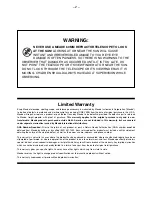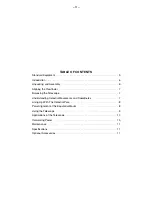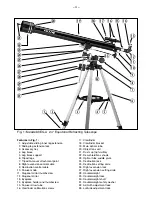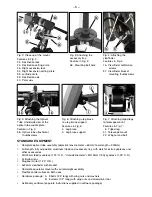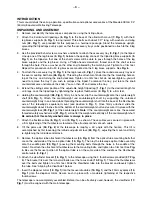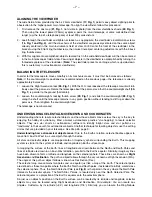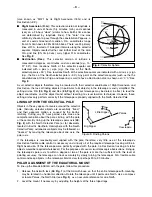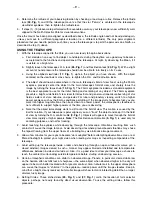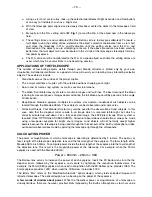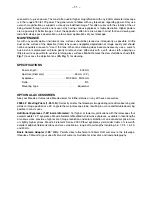
– 9 –
3. Determine the latitude of your observing location by checking a road map or atlas. Release the latitude
lock (
33, Fig. 1) and tilt the telescope mount so that the star “Polaris” is centered in the telescope’s
viewfinder eyepiece, then re-tighten the latitude lock.
4. If steps (1) - (3) above were performed with reasonable accuracy, your telescope is now sufficiently well-
aligned to the North Celestial Pole for visual observations.
Once the mount has been polar-aligned as described above, the latitude angle need not be adjusted again,
unless you move to a different geographical location (i.e. a different latitude). The only polar alignment
procedure that you need to perform each time you use the telescope is to point the polar axis due North, as
described in step (1) above.
USING THE TELESCOPE
1.
With the telescope aligned to the Pole, you are now ready to begin observations.
a.
First, decide on an easy to find object. Land objects, during the daytime are a good way to become
accustomed to the functions and operations of the telescope. At night, try observing the Moon, if it
is visible, or a bright star.
b.
Slightly loosen the telescope’s R.A. lock (
26, Fig. 1) and Declination lock (24, Fig. 1). With a slight
amount of hand-pressure the telescope should now be able to turn freely on its 2 axes.
c.
Using the aligned viewfinder (
17, Fig. 1), sight-in the object you have chosen. With the object
centered on the viewfinder’s cross hairs, re-tighten the R.A. and Declination locks.
d.
The object should now be somewhere in the main telescope’s field of view. Next, using the 25mm
eyepiece, precisely center the object in the main telescope’s field of view, and sharply focus the
image by turning the focus knob (
10, Fig. 1). The 25mm eyepiece included as standard equipment
is the best eyepiece to use for the initial finding and centering of any object. The 25mm eyepiece
presents a bright, wide field of view, ideal for terrestrial and general astronomical observing of star
fields, clusters of stars, nebulae, and galaxies. For lunar and planetary viewing, switch to a higher
power eyepiece such as the 9mm–conditions permitting. If the image starts to become fuzzy as you
work into higher magnifications, then back down to a lower power; the atmospheric steadiness is
not sufficient to support higher powers at the time you are observing.
e.
Note that the object immediately starts to drift out of the field of view. This motion is caused by the
Earth’s rotation. If your telescope is polar aligned, you can “track” the object and keep it in the field
of view by turning the R.A. control cable (
8, Fig. 1). Objects will appear to move through the field of
view more rapidly at higher powers.
Note: The Declination control cable (9, Fig. 1) is used only for
centering purposes, and not for tracking.
2.
Avoid touching the eyepiece while observing through the telescope. Vibrations resulting from such
contact will cause the image to move. Avoid observing sites where ground-based vibrations may shake
the tripod. Viewing from the upper floors of a building may also introduce image movement.
3.
Allow a few minutes for your eyes to become “dark adapted” before attempting observations. Use a red-
filtered flashlight to protect your night vision when reading star maps or inspecting components of the
telescope.
4.
Avoid setting up the telescope inside a room and observing through an open window (or worse yet, a
closed window). Images viewed in such a manner may appear blurred or distorted due to temperature
differences between inside and outside air. Also, it is a good idea to allow your telescope a chance to
reach the ambient (surrounding) outside temperature before starting an observing session.
5.
Certain atmospheric conditions can distort an observed image. Planets, in particular, viewed while low
on the horizon often exhibit lack of sharpness—the same object when observed higher in the sky will
appear to be much better resolved with far greater contrast. Also, turbulent air in the upper atmosphere
can cause the images to “shimmer” in the eyepiece—reduce power until the image steadies. Keep in
mind that a bright, clearly resolved, but smaller image will show far more interesting detail than a larger,
dimmer, fuzzy image.
6.
Setting Circles: These etched dials (
25, Fig. 1) and (27, Fig. 1) aid in the location of faint celestial
objects, perhaps, not easily found by direct visual observation. To use the setting circles, follow this
procedure:
Содержание 60EQ-A
Страница 12: ......


